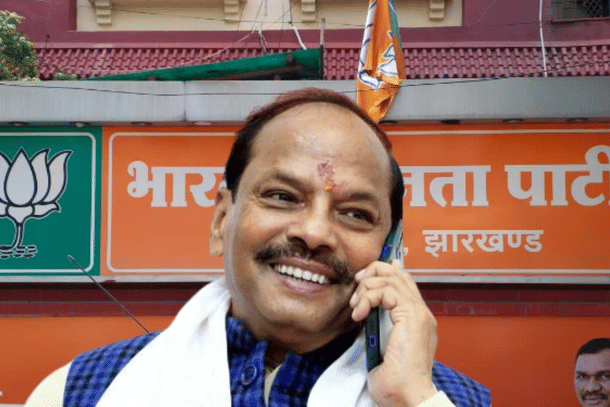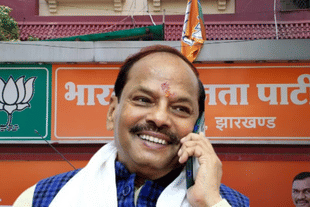Politics
Raghubar Das Back In Jharkhand: Is BJP Correcting An Error Or Repeating One?
Abhishek Kumar
Jan 15, 2025, 04:45 PM | Updated 04:44 PM IST
Save & read from anywhere!
Bookmark stories for easy access on any device or the Swarajya app.


Former Odisha governor Raghubar Das has rejoined the parent Bharatiya Janata Party (BJP), with a primary focus on improving the party’s prospects in Jharkhand.
He was appointed as the governor of Odisha in October 2023, which was seen as the BJP’s attempt to avoid alienating its tribal leaders and voters. The party’s loss in the Jharkhand assembly election reopened the doors for his return.
The reception was grand. Before his arrival in Ranchi, the city was adorned with posters and welcoming messages for Das. The party's state unit president, Babulal Marandi, working president Ravindra Rai, and Union minister Sanjay Seth, among others, were present at the occasion.
Das is expected to either replace Marandi as the state president or be assigned another senior position, leveraging his unique selling point as a cadre-based leader. Das joined the Jan Sangh as a casual cadre in the 1970s and is widely regarded as an ideologically committed individual.
It was due to his commitment and strong connections within the party cadre that the BJP took the bold step of pitching a non-tribal (Das himself) as chief minister in the state. Das went on to become the first chief minister to complete a full five-year term in Jharkhand.
Within hours of rejoining the party, Das appeared to be back in action, making statements on issues designed to energise the party cadre.
The first issue he addressed was religious conversions in the Santhal Pargana region. He recalled that during his tenure as chief minister, Jharkhand became the first state to ban the Popular Front of India (PFI).
“Jharkhand was the first state to ban the PFI, but their activities are once again on the rise in Santhal Pargana. The government must take action to curb this unconstitutional activity,” said Das, focusing on conversion and infiltration issues.
In Bundu, he urged the Hemant Soren government to implement the Panchayat (Extension to Scheduled Areas) Act, 1996 (PESA).
Jharkhand is one of the states with several districts notified under the Fifth Schedule of the Indian Constitution, which governs the administration of Scheduled Areas and Scheduled Tribes. The Fifth Schedule restricts the implementation of panchayat-related provisions in these areas.
According to Das, PESA is intended to remove this barrier and ensure that traditional village heads — Manki, Munda, and other institutions — are granted rights concerning local affairs like minor minerals.
In essence, PESA empowers Gram Sabhas to make decisions while reducing the state government's control, established through tenancy acts.
Das claims that his government had prepared a draft for its implementation in 2019, but the model code of conduct and subsequent change in administration prevented its execution.
Das is now calling on the Soren government to fulfil its mandate or face street protests. This approach aligns with his image, as even during his governorship, he would visit places, meet people, and personally sanction funds to assist them.
Das’ return has a tumultuous history. He had positioned himself for the 2024 Jharkhand assembly election, but this did not materialise for various reasons, primarily his status as an Other Backward Class (OBC) leader.
When the BJP selected him as chief minister in 2014, it was a period of experimentation. Riding the Modi wave, the party sought to consolidate smaller voter groups into a substantial vote bank, countering the numerically dominant castes.
For example, in Haryana, the BJP went against the Jats and appointed Manohar Lal as chief minister. This strategy proved effective in 2019 and 2024.
In the 2014 Jharkhand assembly election, the BJP took a gamble by appointing a non-tribal chief minister, challenging the prevailing political narrative of selecting candidates from the tribal population, which comprised over 26 per cent of the state's population according to the 2011 census. The party won the election, and Das became chief minister.
During his tenure, Das also took an unpopular stance on governance. To open tribal areas to industrialisation and integrate them into the mainstream, he attempted to amend the Chotanagpur Tenancy (CNT) Act, 1908, and the Santhal Pargana Tenancy (SPT) Act, 1949.
These acts prohibit the commercial use of tribal lands, which Das sought to change.
The opposition accused the BJP and Das of attempting to usurp tribal land rights, a narrative exploited by the Jharkhand Mukti Morcha (JMM) to foster anti-BJP sentiments among the tribals. Das’ conflict with Saryu Roy further compounded his problems.
The tribal electorate did not forgive the BJP, reducing its tally to two seats in the 2019 election, an 82 per cent decline from the 2014 count of 11 seats. Das himself lost his seat to Roy, who turned the Jamshedpur East constituency into a battleground of egos.
Despite Das’ accomplishments during his tenure, public sentiment was against him. The BJP became desperate to reclaim tribal votes from the JMM, necessitating a strategic realignment.
The party brought back Marandi, its tribal face and the first chief minister of Jharkhand, appointing him as state president and the likely chief ministerial candidate.
With Marandi at the helm, Das’ loyalists felt marginalised. Internally, both factions often clashed over strategies and activities. The BJP had no choice but to appoint Das as the governor of Odisha.
Even from the governor’s office, reports of Das holding meetings about Jharkhand continued to surface. Both the Biju Janata Dal and JMM accused Das of interference. Although he couldn’t secure his own comeback, Das managed to get his daughter-in-law, Purnima Sahu, nominated for the Jamshedpur East constituency.
Sahu ultimately won the seat, defeating Ajoy Kumar, a former police officer instrumental in Jamshedpur’s industrial development.
Meanwhile, the BJP suffered a humiliating defeat, securing only 21 seats.
For OBC votes, the National Democratic Alliance (NDA), led by the BJP, relied more on Sudesh Mahto of the All Jharkhand Students Union Party (AJSUP). However, the AJSUP won only one seat, and Mahto himself lost from the Silli constituency.
The charisma once associated with Mahto is now more apparent in Jairam Mahato of the Jharkhand Loktantrik Krantikari Morcha (JLKM). His advocacy for local job preferences, language promotion, and anti-outsider rhetoric attracted large crowds. Although Mahato was the sole winner from his party, he and his party hurt the NDA in over a dozen seats.
For BJP, its tribal outreach strategy, which compromised its pro-OBC stance, had failed. In tribal areas, it lacked cadre strength, while in non-tribal areas, it failed to motivate voters.
Now the party seems determined to rectify its mistakes. Its biggest strategic error was focusing too much on tribal votes during Hemant Soren’s political peak. It failed to effect significant changes on the ground, while OBC voters felt sidelined.
With Das’ return, it is now up to him to revitalise the party’s cadre and prepare a new generation of leaders while ensuring that existing members are adequately positioned. Observers of Jharkhand politics understand that Das is the only person in the BJP capable of achieving this.
The main challenge remains the potential conflict with Marandi. For now, it appears that Marandi will oversee the party’s legislative strategies, while Das will focus on strengthening the organisational framework.
It would not be surprising if Das cultivates enthusiastic tribal leaders, grooming them for leadership positions, as Marandi, Arjun Munda, and Champai Soren are now waning in influence.
Abhishek is Staff Writer at Swarajya.




